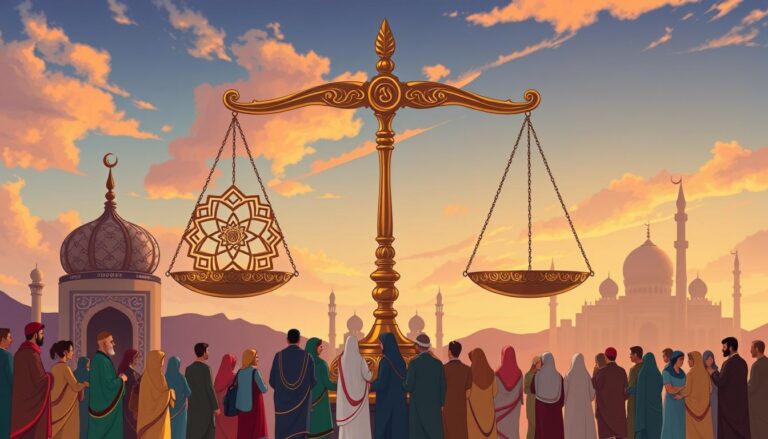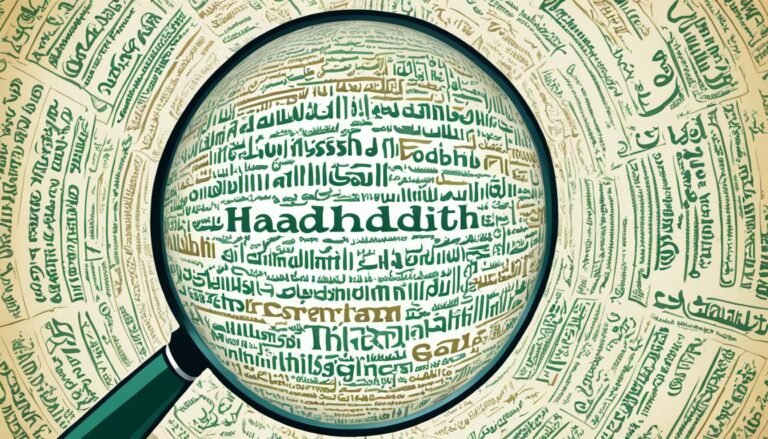Decoding Contradictions: How Some Hadiths Diverge from Quranic Teachings
Have you ever thought about why some Hadiths seem to go against the Quran’s main teachings? This question is key to understanding Islamic texts and their meanings. As we explore these contradictions, it’s vital to know the importance of the Quran and Hadiths in Islam.
The Quran is the main source of Islamic law and values. Hadiths, which record the Prophet Muhammad’s words and actions, often tell different stories. This article will look into Hadith differences and how they question our view of Quranic teachings. By analyzing Hadiths, we’ll find out why these differences exist and what they mean for today’s faith and actions.
Key Takeaways
- The Quran is the foundational text of Islamic teachings, while Hadiths provide supplementary guidance.
- Understanding Hadith discrepancies can illuminate varying interpretations of Quranic principles.
- Exploring contradictions encourages deeper reflection on the nature of faith.
- Hadith analysis is crucial for recognizing the complexities within Islamic traditions.
- Contradictions may reflect historical contexts and evolving beliefs within the Muslim community.
Understanding the Quran and Hadiths
The Quran, seen as God’s exact words, is key to Islamic faith. It was given to the Prophet Muhammad by the angel Gabriel over 23 years in the 7th century CE. It guides on life, law, and spirituality. Muslims believe it’s the final and full message from God, replacing earlier scriptures.
It teaches strong monotheism, showing humanity the right path.
Hadiths are reports of the Prophet Muhammad’s words, actions, and approvals. They help explain the Quran’s teachings. These religious texts are crucial for Islamic traditions.
They show how to apply Quranic teachings in daily life. This makes understanding and living Islam easier.
There are debates about the Quran and Hadiths’ history and truth. This has led to scholarly discussions. The International Institute of Islamic Thought was set up in 1981 to tackle these issues.
It aims to improve Islamic scholarship. It works to solve problems in Quranic studies and Islamic thought today. It does this through its publications and outreach in English and Arabic.
The Quran’s language is known for its beauty and rhythm. Some say its style is a miracle. Chapters like “Sura al-Muddaththir” show its deep impact.
Today, we talk about how the Quran mentions the sun and moon’s paths. This shows it’s still relevant today.
The Role of Hadith in Islamic Traditions
Hadiths are key to Islamic traditions. They guide religious practices and deepen our understanding of Islamic teachings. These stories come from the Prophet Muhammad. They show us how he lived and what he said, helping us follow his example in our lives.
Hadiths do more than just tell stories. They help shape Islamic law and teach us right from wrong. They make it clear how to live a life that follows the Quran. This shows how important Hadiths are for understanding the Quran and living by its teachings.
Hadiths also guide us in our rituals and how we act in our communities. They make our spiritual journey deeper and bring us closer together. By doing what the Hadith teaches, we do good for ourselves and others. This makes the Hadith significance clear in our faith.
In summary, Hadiths and Islamic teachings work together to shape our lives. Here’s a table that shows how Hadiths affect our religious practices:
| Component | Description |
|---|---|
| Legal Framework | Establishes rules and regulations governing Islamic law. |
| Moral Guidance | Offers ethical teachings that promote positive behavior. |
| Ritual Practices | Guides the performance of essential religious rituals. |
| Community Strengthening | Fosters unity and belonging among Muslims through shared beliefs. |
| Spiritual Enrichment | Enhances personal and communal spiritual growth. |
Decoding Contradictions: How Some Hadiths Diverge from Quranic Teachings
The debate about Hadith and Quranic teachings is ongoing among scholars and followers. Some Hadiths seem to go against the Quran’s main teachings. This section looks at these contradictions and how they are understood in Islamic traditions.
Overview of Key Hadiths and Their Interpretations
Many Hadiths are important in Islamic history. Yet, some are questioned for not matching Quranic teachings. For example, some stories about hypocrisy might seem confusing when compared to the Quran’s clear message of monotheism.
The Quran is seen as the direct word of God. It gives a clear message that goes beyond earlier religious texts. Some Hadiths talk about dishonesty or betrayal, which can be hard to reconcile with the Quran’s focus on faith’s purity.
Understanding these Hadith contradictions requires looking at their historical context. Early Islamic society faced many challenges, like fear and greed, which influenced these stories. Scholars have looked into these issues, wondering if early interpretations were affected by culture or politics.
Today, it’s important to consider both new and old interpretations of these Hadiths. This helps us gain deeper insights into how Hadith, Quranic teachings, and Islamic traditions interact. It shows the complex nature of faith and how it can be understood in different ways.
The Significance of Quranic Teachings in Islam
The Quran is the core text of Islam, filled with moral teachings and ethics. It guides Muslims all over the world. With 114 chapters and 6,348 verses, it covers many topics, from faith to how to live. These teachings help shape the ethics of millions, making the Quran very important in understanding Islamic culture and laws.
Core Principles and Ethical Guidelines
Quranic teachings focus on key principles of Islamic ethics. Justice, mercy, and charity are central to how individuals and communities act. Zakat, a form of charity, shows the value of helping others to keep society fair. This idea of community, or Ummah, promotes working together and supporting each other.
- Justice: The Quran calls for fairness and treating everyone with respect and dignity.
- Mercy: It teaches believers to be kind and forgiving.
- Charity (Zakat): This act of giving helps the poor and builds community ties.
- The Importance of Community (Ummah): It stresses the need for Muslims to work together and support each other.
When Muslims look to the Quran for guidance, these principles guide them through life’s challenges. Following these teachings helps them live well and interact with others in a healthy way.
| Principle | Description |
|---|---|
| Justice | Promoting fairness and integrity in relationships and societal structures. |
| Mercy | Demonstrating kindness and forgiveness in personal and communal interactions. |
| Charity (Zakat) | Encouraging financial responsibility towards aiding those in need. |
| Community (Ummah) | Fostering a sense of belonging and mutual support among Muslims. |
Hadith Authenticity: Examining Sources and Narrations
Checking if a Hadith is true is key in Islamic studies. Scholars look at chains of narration, or Isnad, to judge its trustworthiness. These chains show who passed on the Hadith, helping to sort them into strong or weak groups.
To check if a Hadith is reliable, scholars dig into the backgrounds of those who shared it. They look at their honesty, memory, and links to others. This helps spot fake Hadiths.
Here are some things that affect if a Hadith is true:
- Historical context: Knowing when the Hadith was shared helps judge its truth.
- Consistency: Seeing if the Hadith fits with Islamic beliefs and the Quran is important.
- Reputation of narrators: Checking if the people sharing the Hadith are trustworthy is key.
Talking about Hadith truth affects big religious debates and daily life. The link between Hadith and the Quran’s teachings means scholars and followers must be very careful.
| Classification | Description | Examples |
|---|---|---|
| Sahih | Authentic and strong Hadith, widely accepted in Islamic teachings | Hadith narrated by Bukhari and Muslim |
| Da’if | Weak Hadith, lacking sufficient reliable narrators | Various narrations with poor chains of transmission |
| Hasan | Good Hadith, considered acceptable but not as strong as Sahih | Narrations found in Sunan Abu Dawood |
| Mutawatir | Hadith narrated by a large number of people at every level of transmission | Statements about the Quran’s revelation |
| Ahad | Hadith transmitted by an individual, considered less authoritative | Other lesser-known narrations |
Common Themes: Hadith vs. Quranic Teachings
Looking at Hadiths and Quranic teachings shows us common themes. These themes reveal both harmony and differences. They highlight how some Hadiths might seem to go against Quranic teachings. This is especially true when we look at early Islamic history.
Understanding these differences helps us get a deeper look into Islamic thought. It also encourages us to think critically about these teachings.
Contradictory Narratives in Early Islamic History
Many stories from early Islamic times show us how the community was shaped. Some Hadiths seem to go against what the Quran says. This raises questions that need careful thought.
These differences come from various reasons. They include the context of the story, when it was written, and how scholars interpret it.
In “Paradise of the Pious” by Imam An-Nawawi, stories use figurative language to teach morals. But, they don’t always match the clear rules in the Quran. This shows the challenge of fitting Hadiths with Quranic teachings.
The history behind these Hadiths is key to understanding them. The way Hadiths were passed down and written adds more complexity. Scholars sort Hadiths into ‘Sound,’ ‘Good,’ and ‘Weak’ types, based on their trustworthiness.
This sorting changes how these stories fit into Islam and how people use them for guidance.
Looking at these different views helps us talk about religious practices today. It shows how Islamic law is always changing. The relationship between Hadiths and Quranic teachings is crucial for scholars and followers. It leads to ongoing talks about faith and practice in Islam.
Methodologies for Analyzing Hadith Discrepancies
Studying Hadith discrepancies needs a detailed approach. Scholars use various methods for effective analysis. It’s key to know how these methods change how we understand Hadiths and their link to the Quran. Exploring these methods deeply can show us a lot about Islamic texts and traditions.
Scholarly Approaches to Hadith and Quranic Comparison
There are many ways to study Hadiths and compare them with the Quran. Each method gives its own view and tools. Here are some common ones:
- Critical-Historical Method: This looks at the history behind Hadiths. It helps us understand when and why they were written.
- Textual Criticism: Scholars check the Hadith texts for changes over time. They look for differences to see if parts were added or changed.
- Hermeneutics: This method is about interpreting Islamic texts. It helps us understand and put into context Hadiths and the Quran, solving any seeming contradictions.
These methods are crucial in Islamic studies. By using Hadith analysis and comparing it with the Quran, scholars can have deep discussions. They can show the many meanings in Islamic teachings.
| Methodology | Description | Key Focus |
|---|---|---|
| Critical-Historical Method | Analyzes the historical contexts surrounding Hadiths. | Contextual understanding of Hadith origins. |
| Textual Criticism | Examines variations in Hadith texts to assess authenticity. | Integrity and accuracy of texts. |
| Hermeneutics | Interprets Hadiths and the Quran, resolving contradictions. | Comprehensive understanding of meanings and implications. |
Understanding Historical Contexts of Hadiths
Exploring Hadith origins means looking at the historical background of their creation. Early Islamic history was key in shaping these texts. The time’s social and political scene played a big role in how the Prophet Muhammad’s companions recorded and shared Hadiths. Each companion added their own stories and views, making Islamic tradition rich and diverse.
Key factors to consider include:
- The political dynamics that affected the companions’ relationships and their motivations for recording Hadiths.
- The cultural landscape of early Muslim communities that shaped their interpretation of events and teachings.
- The role of various scholarly schools in legitimizing specific Hadiths over others, impacting Islamic jurisprudence and belief systems.
Looking into these historical times shows the complexity in sharing Hadiths. Loyalty among the companions often decided which Hadiths were kept and spread. Knowing this history helps us understand Hadiths better. It shows us that analyzing Hadiths is more than just looking at the words. It’s about seeing the history that Islamic teachings come from.
| Factor | Description | Influences on Hadiths |
|---|---|---|
| Political Dynamics | Relationships among companions influenced recording and transmission of Hadiths. | Selection of Hadiths based on political allegiances. |
| Cultural Landscape | Cultural values shaped interpretations and significance of Hadiths. | Local customs may impact the acceptance of certain Hadiths. |
| Scholarly Schools | Different schools of thought prioritized certain Hadiths over others. | Legitimization of Hadiths affected Islamic law and traditions. |
Implications of Hadith Contradictions on Faith and Practice
Hadith discrepancies bring big challenges to today’s Muslims. These issues can make people doubt the true words of religious texts. This leads to faith challenges for those who want clear beliefs. When Hadiths don’t match Quranic teachings, followers might question their faith’s basics.
These differences can also split communities. They lead to many different views, causing a mixed understanding of Islamic practices. This can make it hard for communities to stick to Islamic values. As people deal with these issues, they start talking more, looking for ways to follow Islam’s true spirit.
To deal with Hadith discrepancies, we need a balanced view. Modern scholars and leaders are re-checking Hadiths against Quranic teachings. This helps Muslims understand their faith better and stay strong in their beliefs.
Looking into and talking about Hadith discrepancies helps us understand Islam better. This process helps shape our personal and group identities. It makes sure Islamic practices stay important and fit for today’s world.
| Implication | Description |
|---|---|
| Faith Challenges | Individuals question the authenticity of their beliefs due to conflicting texts. |
| Community Division | Diverse interpretations may lead to fragmentation within the Muslim community. |
| Reevaluation of Practices | Leaders encourage revisiting Hadith in light of Quranic teachings for better alignment. |
| Ongoing Dialogue | New discussions promote understanding and clarity regarding fundamental beliefs. |
| Relevant Faith | Ensuring that Islamic practices resonate with contemporary values and insights. |
Conclusion
Exploring Islamic teachings has shown us the deep connection between the Quran and Hadith. Understanding these texts is complex because different people see them in different ways. Scholars are working hard to help believers get closer to their faith.
Looking at the Hadith and Quran together is crucial. It leads to deeper discussions about what these texts mean. By studying these differences, we learn more about Islamic beliefs and practices. This helps us understand Islam better.
We need to keep exploring and learning about the Quran and Hadith. By studying these texts deeply, people can grow closer to their faith. This shows how important both the Quran and Hadith are in today’s Islamic life.
Source Links
- Microsoft Word – 2022_5_12_Dissertation (1)
- Decoding the Egalitarianism of the Qur’an: Retrieving Lost Voices on Gender 9781793609892, 9781793609908 – EBIN.PUB
- Layout 1
- Scientific Errors in the Quran
- Criticism of the Quran
- Lecture (30) Decoding Deception: Insights into Hypocrisy from Surat At-Tawbah – Imam Karim AbuZaid
- Decoding the obscure origins of Islam
- Quran
- Ijtihād Holds Supremacy in Islamic Law: Muslim Communities and the Evolution of Law
- The use of figurative language in the hadiths of prophet muhammad (p.b.u.h.) in the book paradise of the pious by imam an-nawawi
- The Muslim Difference: Defining the Line between Believers and Unbelievers from Early Islam to the Present
- Modern Islamic Thinking and Activism
- Understanding the Prophetic Hadith: Issues Related to the Translation of Mishkāt ul-Maṣābīḥ [1 ed.] 9781003256342, 9781032149813, 9781032188072 – DOKUMEN.PUB
- The Bāb and ʿAlī Muḥammad, Islamic and Post-Islamic: Multiple Meanings in the Writings of Sayyid ʿAlī Muḥammad Shīrāzī (1819–1850)
- Philosophy of Islamic Law.QXP







